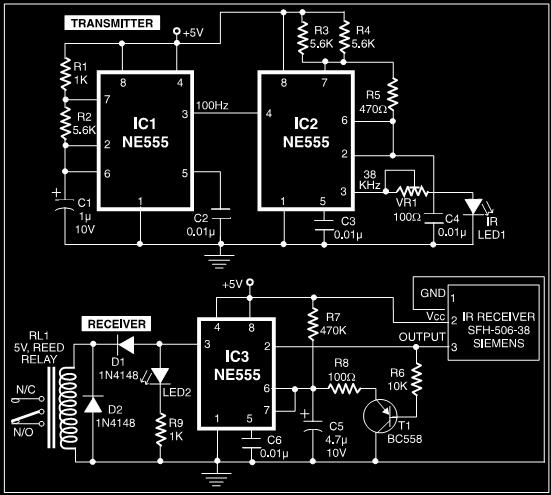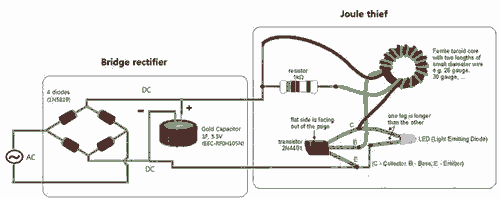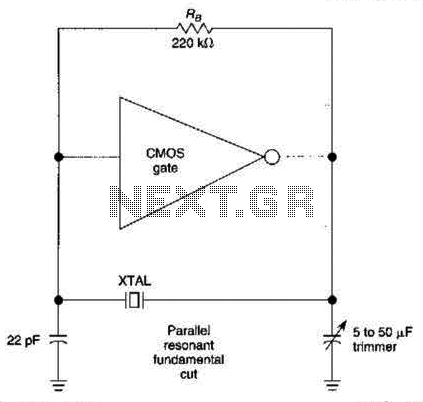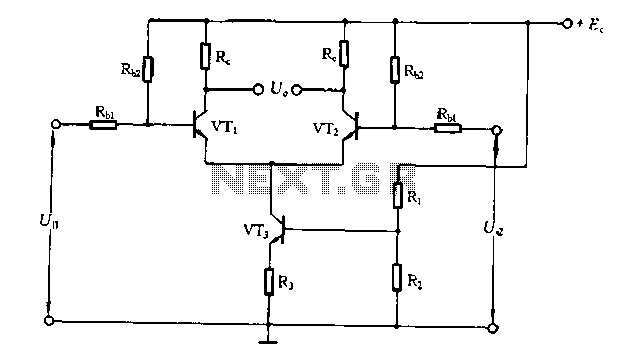
Proximity Detector Circuit Using NE555 PCB

This post discusses a proximity detector circuit primarily utilizing the NE555 integrated circuit (IC). The circuit is designed for burglar alarms based on beam interruption, with the advantage that the transmitter and receiver are contained within the same enclosure, eliminating wiring complications. The proximity detector employs an infrared diode detector, which can be implemented in various applications, including burglar alarms, touch-free proximity switches for activating lights, and solenoid-controlled valves for operating water taps. The circuit features an infrared transmitter and an infrared receiver, such as the Siemens SFH506-38 used in television sets.
The transmitter consists of two 555 timers (IC1 and IC2) configured in astable mode to drive an infrared LED. A burst output of 38 kHz, modulated at 100 Hz, is necessary for the infrared detector to detect the transmission, thus the specific configuration is required. To conserve power, the duty cycle of the 38 kHz astable multivibrator is maintained at 10 percent. The receiver section includes an infrared detector with a 555 timer (IC3) set up in monostable mode, followed by a PNP transistor (T1). Upon receiving infrared signals, the monostable 555 timer is activated and remains on as long as the signals are detected. When signals cease, the timer deactivates after a delay determined by the resistor-capacitor combination (R7-C5). The delay achieved using a 470 kΩ resistor and a 4.7 µF capacitor is approximately 3 seconds. Unlike a conventional monostable circuit, the capacitor in this configuration only charges when signal reception has stopped, due to the PNP transistor (T1) shorting the charging capacitor while the output from the infrared receiver module is active (low state). This arrangement can detect the proximity of a moving object. Both the transmitter and receiver can be mounted on a single breadboard or PCB, with the consideration that the infrared receiver should be positioned behind the infrared LED to prevent issues from infrared leakage. An object moving nearby reflects the infrared rays emitted from the infrared LED. The infrared receiver has a sensitivity angle of 60 degrees, allowing it to sense IR rays within this range, thereby triggering the monostable in the receiver section. This principle can be utilized to activate a light using a relay when a person approaches, with the light automatically turning off after a set time when the person moves away. Sensitivity is influenced by the current-limiting resistor in series with the infrared LED, and it has been observed that with a preset resistance of 20 ohms, an object can be detected at a distance of approximately 25 cm.
The proximity detector circuit is a versatile solution for various applications requiring non-contact sensing. The NE555 timer's dual functionality allows for efficient modulation and signal processing, making it suitable for environments where space and wiring constraints are present. The use of infrared technology enhances the circuit's effectiveness in detecting motion or presence without physical contact, which is beneficial for safety and convenience in applications like lighting control and security systems. The careful arrangement of components, particularly the placement of the infrared receiver in relation to the LED, ensures optimal performance and minimizes false triggers due to ambient infrared sources. The adaptability of this circuit allows for customization based on specific requirements, such as adjusting sensitivity or delay times through component selection and configuration.This post shares a proximity detector circuit comprising mainly NE555 IC. This circuit can be used for burglar alarms based on beam interruption, with the added advantage that the transmitter and receiver are housed in the same enclosure, avoiding any wiring problems. This proximity detector is constructed using an infrared diode detector. Infrare d detector can be used in various equipment such as burglar alarms, touch-free proximity switches for turning on a light, and solenoid controlled valves for operating a water tap. Briefly, the circuit consists of an infrared transmitter and an infrared receiver (such as Siemens SFH506- 38 used in TV sets).
The transmitter part consists of two 555 timers (IC1 and IC2) wired in astable mode, as shown in the figure, for driving an infrared LED. A burst output of 38 kHz, modulated at 100 Hz, is required for the infrared detector to sense the transmission; hence the set-up as shown is required.
To save power, the duty cycle of the 38kHz astable multivibrator is maintained at 10 per cent. The receiver part has an infrared detector comprising IC 555 (IC3), wired for operation in monostable mode, followed by pnp transistor T1. Upon nreception of infrared signals, the 555 timer (mono) is turned on` and it remains on` as long as the infrared signals are being received.
When no more signals are received, the mono goes off` after a few seconds (the delay depends on timing resistor-capacitor combination of R7-C5). The delay obtained using 470kilo-ohm resistor and 4. 7 µF capacitor is about 3 seconds. Unlike an ordinary mono, the capacitor in this mono is allowed to charge only when the reception of the signal has stopped, because of the pnp transistor T1 that shorts the charging capacitor as long as the output from IR receiver module is available (active low).
This setup can be used to detect proximity of an object moving by. Both transmitter and receiver can be mounted on a single breadboard/PCB, but care should be taken that infrared receiver is behind the infrared LED, so that the problem due to infrared leakage is obviated. An object moving nearby actually reflects the infrared rays from the infrared LED. As the infrared receiver has a sensitivity angle of 60 degree, the IR rays are sensed within this lobe and the mono in the receiver section is triggered.
This principle can be used to turn on` the light, using a relay, when a person comes nearby. The same automatically turns off` after some time, as the person moves away. The sensitivity depends on the current-limiting resistor in series with the infrared LED. It is observed that with in-circuit resistance of preset VR1 set at 20 ohms, the object at a distance of about 25 cms can be sensed. 🔗 External reference
The transmitter consists of two 555 timers (IC1 and IC2) configured in astable mode to drive an infrared LED. A burst output of 38 kHz, modulated at 100 Hz, is necessary for the infrared detector to detect the transmission, thus the specific configuration is required. To conserve power, the duty cycle of the 38 kHz astable multivibrator is maintained at 10 percent. The receiver section includes an infrared detector with a 555 timer (IC3) set up in monostable mode, followed by a PNP transistor (T1). Upon receiving infrared signals, the monostable 555 timer is activated and remains on as long as the signals are detected. When signals cease, the timer deactivates after a delay determined by the resistor-capacitor combination (R7-C5). The delay achieved using a 470 kΩ resistor and a 4.7 µF capacitor is approximately 3 seconds. Unlike a conventional monostable circuit, the capacitor in this configuration only charges when signal reception has stopped, due to the PNP transistor (T1) shorting the charging capacitor while the output from the infrared receiver module is active (low state). This arrangement can detect the proximity of a moving object. Both the transmitter and receiver can be mounted on a single breadboard or PCB, with the consideration that the infrared receiver should be positioned behind the infrared LED to prevent issues from infrared leakage. An object moving nearby reflects the infrared rays emitted from the infrared LED. The infrared receiver has a sensitivity angle of 60 degrees, allowing it to sense IR rays within this range, thereby triggering the monostable in the receiver section. This principle can be utilized to activate a light using a relay when a person approaches, with the light automatically turning off after a set time when the person moves away. Sensitivity is influenced by the current-limiting resistor in series with the infrared LED, and it has been observed that with a preset resistance of 20 ohms, an object can be detected at a distance of approximately 25 cm.
The proximity detector circuit is a versatile solution for various applications requiring non-contact sensing. The NE555 timer's dual functionality allows for efficient modulation and signal processing, making it suitable for environments where space and wiring constraints are present. The use of infrared technology enhances the circuit's effectiveness in detecting motion or presence without physical contact, which is beneficial for safety and convenience in applications like lighting control and security systems. The careful arrangement of components, particularly the placement of the infrared receiver in relation to the LED, ensures optimal performance and minimizes false triggers due to ambient infrared sources. The adaptability of this circuit allows for customization based on specific requirements, such as adjusting sensitivity or delay times through component selection and configuration.This post shares a proximity detector circuit comprising mainly NE555 IC. This circuit can be used for burglar alarms based on beam interruption, with the added advantage that the transmitter and receiver are housed in the same enclosure, avoiding any wiring problems. This proximity detector is constructed using an infrared diode detector. Infrare d detector can be used in various equipment such as burglar alarms, touch-free proximity switches for turning on a light, and solenoid controlled valves for operating a water tap. Briefly, the circuit consists of an infrared transmitter and an infrared receiver (such as Siemens SFH506- 38 used in TV sets).
The transmitter part consists of two 555 timers (IC1 and IC2) wired in astable mode, as shown in the figure, for driving an infrared LED. A burst output of 38 kHz, modulated at 100 Hz, is required for the infrared detector to sense the transmission; hence the set-up as shown is required.
To save power, the duty cycle of the 38kHz astable multivibrator is maintained at 10 per cent. The receiver part has an infrared detector comprising IC 555 (IC3), wired for operation in monostable mode, followed by pnp transistor T1. Upon nreception of infrared signals, the 555 timer (mono) is turned on` and it remains on` as long as the infrared signals are being received.
When no more signals are received, the mono goes off` after a few seconds (the delay depends on timing resistor-capacitor combination of R7-C5). The delay obtained using 470kilo-ohm resistor and 4. 7 µF capacitor is about 3 seconds. Unlike an ordinary mono, the capacitor in this mono is allowed to charge only when the reception of the signal has stopped, because of the pnp transistor T1 that shorts the charging capacitor as long as the output from IR receiver module is available (active low).
This setup can be used to detect proximity of an object moving by. Both transmitter and receiver can be mounted on a single breadboard/PCB, but care should be taken that infrared receiver is behind the infrared LED, so that the problem due to infrared leakage is obviated. An object moving nearby actually reflects the infrared rays from the infrared LED. As the infrared receiver has a sensitivity angle of 60 degree, the IR rays are sensed within this lobe and the mono in the receiver section is triggered.
This principle can be used to turn on` the light, using a relay, when a person comes nearby. The same automatically turns off` after some time, as the person moves away. The sensitivity depends on the current-limiting resistor in series with the infrared LED. It is observed that with in-circuit resistance of preset VR1 set at 20 ohms, the object at a distance of about 25 cms can be sensed. 🔗 External reference





